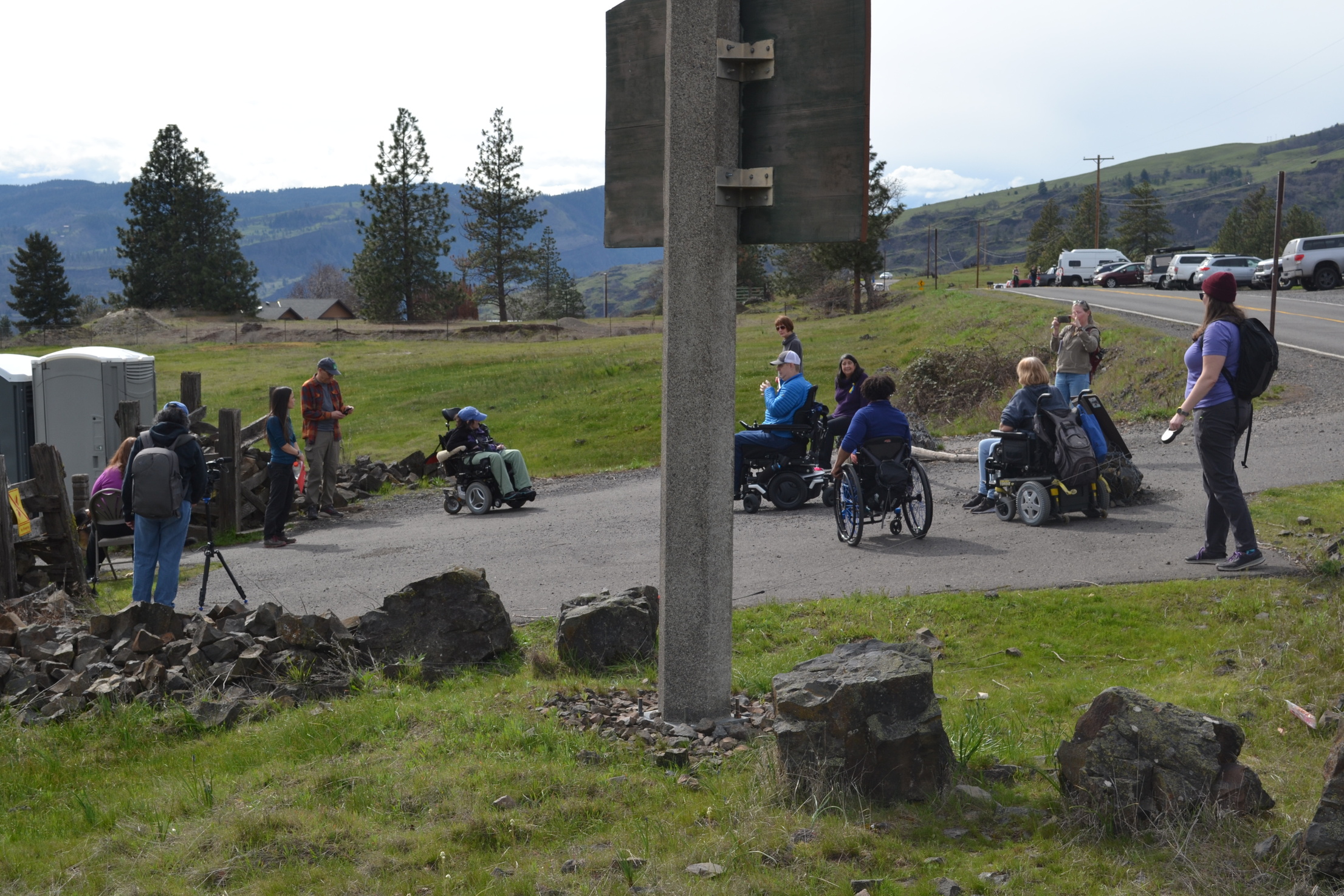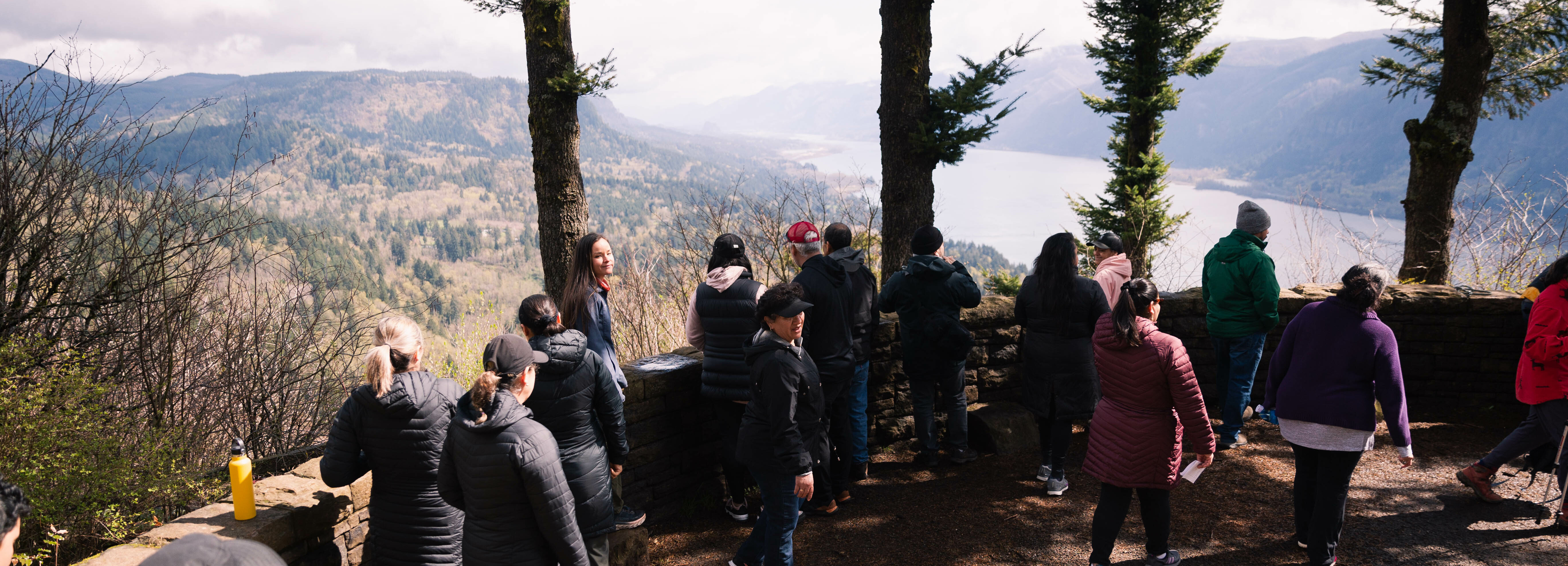One morning last fall, as the soft light of sunrise tinted the Gorge, I loaded a 15-passenger van with water bottles and event handouts for a community hike and listening session. It was a perfect morning for a tour designed to spark imaginations and possibilities for new accessible recreation options on our land trust properties in the Columbia Gorge.
Since completing critical land acquisitions at Cape Horn and Catherine Creek in 2020, Friends of the Columbia Gorge has been investing in community partnerships to improve accessibility and inclusion at these new locations. Unlike many of the steep and rugged lands our acquisitions have protected in the past, the Cape Horn and Catherine Creek preserves feature other attributes: expansive views of the Gorge and relatively level terrain, as well as adjacent public trail systems. These sites do not require navigating narrow switchbacks or climbing rocky scree slopes to experience the grandeur of the Gorge. They have the potential to be more accessible to people of varying abilities.
The Gorge Accessibility Project
In early 2021, as we shifted our focus toward creating a long-term vision for the properties, we began to imagine how these spaces could become accessible for people of varying abilities, ages, and cultural backgrounds to connect with nature in the Gorge. Our conversations brought to life a vision of a Columbia Gorge “open to all.” Those discussions were the catalyst of Friends’ recreation enhancement initiative, called the Gorge Accessibility Project.
Our approach to the Gorge Accessibility Project has been grounded in a commitment to include those who are affected by the “barriers” of accessibility in the Gorge. Those barriers can vary greatly from person to person. Some can be physical (like a narrow dirt trail), cultural (language, race, or ethnicity), or even economic (the privilege of owning a vehicle). To ensure that diverse voices and their concerns were heard, Friends assembled a steering committee that included external partners whose input and expertise could help inform our shared visions for potential recreation enhancements at Cape Horn and Catherine Creek land trust preserves.
A vision team
For more than a year, the steering committee worked through a visioning and planning process to develop conceptual designs for inclusive, accessible spaces. Since both land trust properties are adjacent to public trails, we were fortunate to have U.S. Forest Service as a key partner in the planning process. Equally fortuitous, Mayer/Reed, Inc., a noted Portland-based landscape architecture firm, generously donated their expertise to bring the committee’s imagination onto paper. It was an outstanding team effort.
This team organized visioning sessions with members of the public, professionals, and specialists. These sessions included a series of topical planning meetings and focused community listening sessions. While the topical sessions focused on design considerations such as transportation and accessible gathering spaces, the community listening sessions engaged participants of varying abilities and backgrounds. People with disabilities, families with young children, Indigenous and Latinx Gorge communities, and Black, Indigenous, and People of Color from the Portland tricounty area participated, along with local trail groups.
Widening access to nature
As the concepts and visions congealed, these sessions were critical in helping the steering committee understand what people value when spending time in natural places, and what they experience as barriers to Gorge access. Emergent themes included the value of designing for a range of experiences and abilities, considering the diverse languages spoken in the Gorge, and the importance of protecting and restoring natural habitats.

Concurrently, we undertook assessments and surveys to ensure that potential recreation development is carefully planned so it doesn’t harm natural or cultural resources. To meet those criteria, botanical and wildlife surveys identified “avoidance zones” that would apply to recreation development.
Through 2022, conversations and listening sessions produced ideas and diagrams and eventually led to conceptual designs. Our hope is that the land trust preserves will provide accessible hiking trails, picnicking and gathering spaces, educational features, ecological restoration, and viewpoints of the Gorge.
Moving toward the goal
In June, the steering committee endorsed specific concepts for the Catherine Creek and Cape Horn preserves, striking a balance between developed recreational amenities and restored natural habitats. They include bathrooms and parking, but also new oak groves and wildflower meadows.
Upon completion, the sites will have the potential to enhance the Gorge experience for communities of color, families with young children, individuals with disabilities, and older adults. We’re still a long way from securing this vision, but we know that the Gorge Accessibility Project has already moved us a few steps closer to ensuring that the Columbia Gorge is “open to all.”


